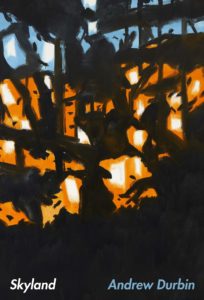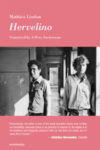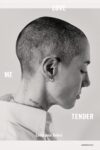
[Nightboat Books; 2020]
I have something that once belonged to Andrew Durbin. A used book of poetry purchased this past winter at Housing Works. The book has an inscription dedicated to someone named “Andrew.” Of course, the chances this actually belonged specifically to Andrew Durbin are one in thousands. But, not unlike the protagonist in Skyland, I am driven by an obsessive conviction — a conviction that masks an even deeper longing for this fiction to simply become my reality. Or at least a generous blend of the two. You see, Skyland is most preoccupied with this very relationship, the one between fiction and reality, or autobiography, and how this relationship is fraught, one streaked by slippage. Durbin uses Hervé Guibert as an entry point, a French artist and writer whose oeuvre is marked with examples of a blurring of the two.
In the novella, the protagonist Andrew — easily a stand-in for Durbin himself — is on the hunt for a rumored portrait of Guibert. He and his friend Shiv — not unlike the real-life poet and critic Shiv Kotecha — plan a trip around visiting Patmos, the Greek island in which the portrait is said to have been left behind. Why is Andrew so consumed by this portrait? Guibert had become an obsession of his, “a constant presence in [his] reading life.” Early on in the novella, Andrew says simply, “I want to see his face.” Then: “I’ve seen his gloomy eyes and shock of curly hair in plenty of self-portraits, but not as someone else had seen him, someone outside of the story he spent his life constructing.”
The protagonist in Skyland admires Guibert for his “experiments in autobiography and in making things up.” The theme of fiction as opposed to — or enmeshed with — autobiography is central to the novella, one that bleeds across the pages, and spins each scene into something to be examined: Durbin is working on his own experiment here, one in which he is blurring the lines of fiction and autobiography himself. “I recognized in him some close proximate of my own desire to mix real life and fiction,” writes Durbin, a hint at the inventive inquiry hidden within the novella.
Durbin makes the interesting choice of subtitling the novella, “a diary,” and each chapter is marked with a specific date. Though the work is labeled as fiction, it is through devices like these that Durbin begins to blur the edges of fiction and autobiography. It is also a very Guibert-like tool, who favored short, diaristic chapters. The very plot of Skyland mirrors moments in Guibert’s The Man in the Red Hat, referenced throughout the novella, and which loosely includes a similar search for a painter and a stay in Greece. In real life, Guibert grew an obsession towards the same painter Yannis Tsarouchis, mentioned in both Skyland and The Man in the Red Hat. All of which adds additional layers of (non-)fiction for Durbin to play with, and for us to puzzle through.
Skyland is Durbin’s follow-up to his debut novel MacArthur Park (2017), easily one of the best releases of that year, and a novel that I have returned to several times since. Durbin’s style remains a blend of auto-fiction with swipes of criticism, though there’s something authoritative at display in the novella form, as if the constrictions provide Durbin with laser-focus. This isn’t a novella of excess. There is no fat to trim. Instead, Skyland is a work of lush precision. It would be easy to compare Durbin’s style to Guibert’s. But I think simply focusing on this parallel would be a disservice to Durbin, whose preoccupations align with Guibert’s at times but whose style easily welcomes comparisons to other French writers. Durbin’s prose is not unlike that of Annie Ernaux, or his contemporary Édouard Louis. Events in the present unfold sparingly, matter-of-factly, the protagonist one prone to meander. But moments accumulate, slowly unfurling, like stacking cards atop each other, one after the other, until you’re hit with the whole stack, the novella somehow having become rather extraordinary. In its unique blend of history and criticism, the novella — despite relying on Guibert — is wholly its own.
Central to Skyland is the protagonist’s obsession with Guibert, how Guibert reflects upon his own writerly desires to blend autobiography and fiction into his work. But Durbin is also interested in asking what the relationship of fiction to larger systems should be, beyond simply the author’s own autobiography. Durbin pointedly pulls into the novella very real moments plaguing the world: what occurred in Charlottesville during a far-right rally in 2017, the refugee crisis in Europe, and Greece more specifically, and how these moments relate to broader systems of racism and oppression, making this novella prescient now more than ever. For the novella to explicitly live in the same space as our social-political reality is significant, and welcome. In a way, this is not unlike Guibert, who placed the injustices he experienced as a man living with AIDS and navigating contrived healthcare systems in the early 1990s central in his final texts. But there’s something a bit haunting here, too; by placing weight on these headier moments, illuminating the legacy of lives lost, with Guibert’s front and center, and employing a prose that is languorous yet understated, Skyland becomes quietly elegiac.
Despite these serious themes, there are moments of pure eros, too, that recall both the classics of gay literature and their more contemporary iterations, like Garth Greenwell’s Cleanness or even Douglas A. Martin’s Outline of My Lover. Certainly, there is more than meets the eye in this slim novella. Skyland tells a story of lust and desire — for men, sure, but for something more complex, too. It’s a story about reaching new planes of discovery within one’s creative practice. Ultimately, Durbin is most interested in pushing the boundaries of what is considered fiction.
Durbin is an intelligent and playful writer. But it’s important to understand how playful of a writer Guibert was, too. He was a master at toying with fates, and upending endings. In Guibert’s universe, a character can pass away only to be resurrected several pages later. “Guibert used death and illness to dissolve and restructure his characters into different versions of themselves through a jerry-rigged immortality,” writes Durbin, who doesn’t rely on death to do the same, but sets up this pursuit for the painting to arrive at a similar sentiment. Through this journey, the protagonist and Shiv shed their skins, becoming something other than their real-life embodiments. Though the novella comes to a kind of conclusion, it’s easy to imagine there is more yet to come. “I can imagine several endings,” writes Guibert in To the Friend Who Did Not Save My Life (incidentally, the introduction to Semiotext(e)’s recent reissue of Guibert’s novel has been written by Durbin). This certainly applies to Skyland as well.
Could the portrait simply be “an elaborate fiction concocted by a writer in his last days”? It doesn’t matter. Whether the protagonist finds the painting or not, he will arrive at a form of victory regardless. There is a success here: “I buzzed with the possibility of my biography-through-the-periphery being shaped not by the real things Guibert left behind — the stories of friends and lovers and artists he knew — but by invented objects, the things-that-never-were-and-never-could-have-been.” He will have discovered something about himself, about his writing, that becomes more valuable than the portrait. It’s nice to imagine the result is what you’re reading. But even better is wondering what Durbin will come to next, and what traces of Guibert’s influences we’ll discover there.
Josh Vigil is a writer living in New York.
This post may contain affiliate links.







